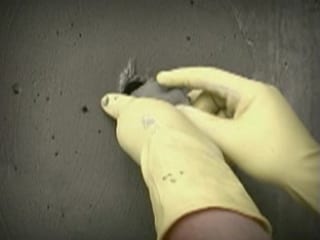USES
CEM290-R is used to instantly stop running water or seepage leaks in concrete or masonry structures. High pressure water flows are repaired and plugged by chiseling a relief point on the concrete, treating the surround by simply rubbing the powder into the wet surface, then plugging the relief hole using a dry pack mix of CEM290-R with water. Force the CEM290-R plug into the relief point and hold in place until set.
CEM290-R is used above or below grade, interior and exterior applications, basements, water retaining structures, water proof concrete segments, tunnels, sewage systems, foundations, pipes, dams, swimming pools, cisterns, reservoirs, water tanks, lift shafts, etc. where the stopping of water leaks instantly is required even under pressure.
APPLICATION
Limitations:
- Do not apply CEM290-R to frozen surfaces.
Coverage:
- 2 Lbs (1 kg) of CEM290-R yields approximately 20 Fl oz (0.6 liters).
- 2 Lbs (1 kg) of CEM290-R will repair approximately a 25.6 inches (65 cm) long crack/cut of 7.87 X 7.87 inch (20 x 20 cm).
Water requirement: 1 volume of potable water is mixed with 3 volumes of CEM290-R.
Surface Preparation: Cut or chisel out the concrete or masonry surrounding the hole or crack, to a minimum depth and width of 18-20 mm. Under cut the crack or hole into a ‘V’ shape cut to provide mechanical bond during initial set and final cure. Flush, blow, or vacuum all loose particles, dust or other foreign materials from the prepared areas. When the relief point for water leak is ready, treat the surround by simply rubbing the dry powder of CEM290-R into the wet surface.
Mixing: Pour potable water into a clean mixing container and gradually add CEM290-R. Use approximately 1 part water to 3 parts CEM290-R by volume. Mix rapidly with a trowel to the consistency of stiff putty with no slump. Mix for no more than 30 seconds. CEM290-R will flash set in 3-5 minutes. Properly mixed CEM290-R can be hand-formed into a ball.
Application:
General Patching: Force CEM290-R into the crack or hole even with surface.
Patching Active Leaks: Hold mixed CEM290-R in hand until warm. Start at the top of opening, firmly forcing CEM290-R into small section of the crack. Hold until set. Continue working down until crack is completely filled and water stops running.
Floor-wall Patching: Follow the above method for similar conditions.
Expansion/Contraction Cracks: Use CEM290-R to stop running water leaks. Do not fill crack completely to surface. Allow approximately ½ inch (≈13 mm) depth and fill with a flexible joint sealer.
Note: In all above methods, use safety rubber gloves for hand protection.
Curing: Standard concrete curing procedures should be followed to prevent rapid water loss and consequent loss of strength.
Cautions:
- Do not re-temper CEM290-R.
- In hotter climates, mix CEM290-R with cold water.
- In cold weather, mix CEM290-R with warm water.
- Use CEM230 for large patches and for under water patching.
Cleaning: clean tools and mixing equipment with water immediately after use.
STORAGE
Indefinite shelf life when stored in cool dry place in unopened container.
SAFETY
CEM290-R is a non-flammable and non-toxic in nature, avoid contact with eyes and skin as it may cause irritation due to its alkaline nature. Splashes of CEM290-R should be washed off immediately with clean water. Wear necessary gloves and dust mask.
WARRANTY
LIMITED WARRANTY: International Chem-Crete Inc. warrants that, at the time and place we make shipment, our materials will be of good quality and will conform to our published specifications in force on the date of acceptance of the order.
DISCLAIMER: The information contained herein is included for illustrative purposes only and, to the best of our knowledge, is accurate and reliable. International chem-crete Inc. is not under any circumstances liable to connection with the use of information. As International Chem-Crete Inc. has no control over the use to which others may put its products, it is recommended that the products be tested to determine the suitability for specific applications and/or our information is valid in particular circumstances. Responsibility remains with the architect or engineer, contractor and owner of the design, application and proper installation of each product. Specifier and user shall determine the suitability of the product for specific application and assume all responsibility in connection therewith. AM220319





